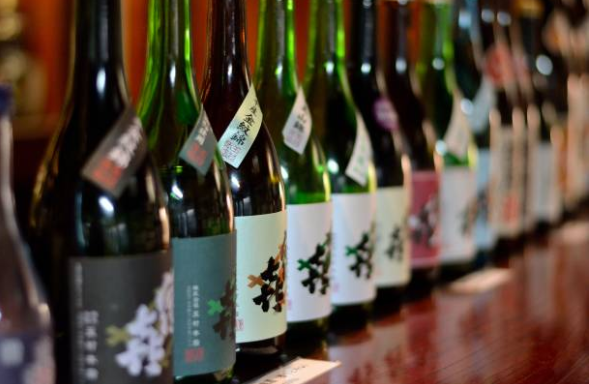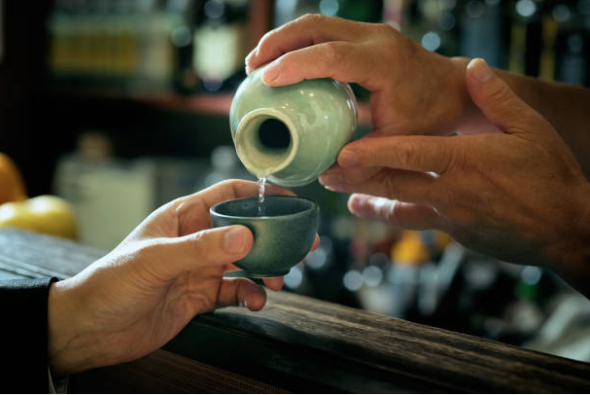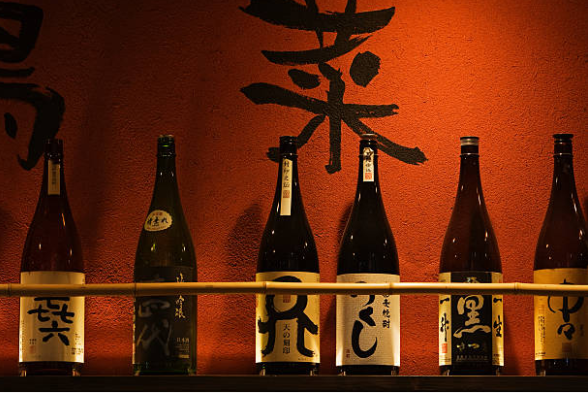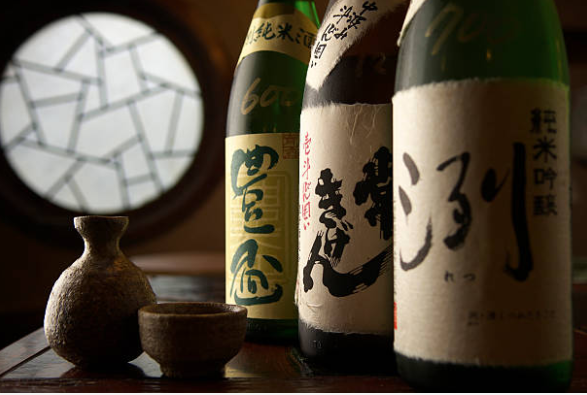What is Sake? What is Japanese Sake Made Of? Curious About How Sake is Made in Japan?
Read the full article on Travel Blog Indonesia Catperku.com!
This article explains the process of making sake and the different types available.
What is the Japanese Beverage Called Sake?

Japanese Sake, also known as Japanese rice wine, is an alcoholic drink that has become a vital part of Japanese cuisine and is listed as UNESCO Cultural Heritage.
Famous among culinary enthusiasts, Japanese sake is one of the traditional alcoholic drinks, alongside distilled sake, shochu. Sake is an alcoholic beverage made from fermented rice, rice koji, and water, with a history stretching back 2,000 years.
This drink is deeply intertwined with Japanese culture, from festivals to Shinto religious rituals.
The umami flavor of sake perfectly complements various dishes, enhancing the dining experience.
Despite being an intoxicating drink, sake’s balanced acidity and umami bring a rich taste to many dishes.
Japanese sake stands as a national symbol of alcoholic beverages, much like French wine, Australian wine, and German beer.
Modern production methods have been introduced in sake brewing, allowing for larger-scale production, but the traditional process remains unchanged.
Every glass of sake reflects the beauty and richness of Japanese cultural traditions, making it a must-try culinary experience when visiting Japan.
Sake and Japanese Culture: An Inseparable Bond

Sake, a well-known Japanese alcoholic beverage, is deeply connected to Japanese culture and history.
Made from fermented rice, it is also known as rice wine.
The process of making sake has been recorded since 700 AD.
In some regions of Japan, the word sake has different meanings. In Southern Kyushu, sake refers to distilled beverages, while in Okinawa, it refers to shochu made from sugar cane.
Sake has an aroma similar to fermented rice (tape). Over time, sake has become an integral part of Japanese culture and traditions, including festivals and Shinto religious rituals.
The Japanese have combined rice, pure water, and the koji microorganism to create sake, also known as Nihon-shu.
Although modern technology has aided the sake-making process over time, sake still retains its unique flavor that pairs well with a variety of dishes.
Thanks to Japan’s geographic isolation from mainland Asia, the Japanese developed a unique culture of sake.
Sake is not just an alcoholic beverage but an invaluable part of Japan’s identity and history.
What Ingredients Make Up Traditional Japanese Sake?

Sake is made by combining four basic ingredients: water, rice, koji, and yeast.
Some types of sake add distilled alcohol during the brewing process, not to increase the alcohol content, but to enhance the flavor.
This phenomenon is known as “Alcohol as a Flavor Creator.”
Here’s an explanation of the ingredients used to make sake:
– Rice: The Defining Ingredient
Sake can be made from Sake Rice (Shuzo-koteki-mai) or Table Rice (the common rice we consume daily).
Sake Rice is more expensive because it is more challenging to cultivate and tends to produce higher-quality sake due to its higher starch content.
While Sake Rice can be eaten like regular rice, it’s better suited for sake production.
Many premium sakes use Yamadanishiki rice, known as the “King of Sake Rice,” but many sake producers now use local rice.
The quality of sake is determined by how much the rice is polished. Generally, the higher the polishing rate, the more premium the sake.
However, sakes with higher polishing rates are usually more expensive but not necessarily “better.”
Remember, everyone’s taste is different! You might find a lower-polished sake more delicious than a more expensive one.
– Water: The Most Abundant Ingredient in Sake
Water makes up 80% of sake.
Using soft water results in a more feminine style of sake, while harder water creates a more masculine flavor.
Water is not only essential for life but is crucial in the sake-making process!
– Koji (Aspergillus oryzae): The Magical Mold
What is Koji? 麹, kōji, or 麹菌, kōji-kin, or Aspergillus oryzae, is the “Magical Mold” that plays a vital role in making soy sauce, shochu, mirin, miso, and of course, sake.
In ancient times, sake was made by chewing cooked rice, spitting it into a container, and allowing it to ferment.
Enzymes in saliva broke down the rice starch into sugar, which then transformed into alcohol.
Fortunately, that method is now obsolete!
Today, Koji is responsible for breaking down rice starch into sugar, which is then ready to ferment into alcohol.
– Yeast: Converts Sugar into Alcohol, Creating the Delicious Aroma of Sake
Yeast is the ingredient that converts sugar into alcohol and creates sake’s aroma.
It’s through yeast that sake experts can produce delightful aromas like green apple, cantaloupe, pineapple, banana, and cherry blossoms (yes, there’s even a sake with a cherry blossom flavor).
It’s Easy to Find Sake Ingredients, But Why Not Try Sake in Japan?
It turns out that sake ingredients are easy to find, right?
Instead of trying to make it yourself, why not travel to Japan and enjoy the best sake right at its source?
Sake’s Role in Local Traditions and Its International Recognition

Sake is often consumed in Shinto purification rites. During World War II, kamikaze pilots drank sake before embarking on their dangerous missions.
A ceremony called kagami biraki involves opening a wooden sake barrel with a mallet during Shinto celebrations, weddings, business openings, sports events, election victories, and other celebrations.
The sake served, known as zake-Iwai (“celebration sake”), is distributed for free to all participants to spread good luck.
On New Year’s Day, many Japanese enjoy a special sake called toso.
Toso is a type of Iwai-zake made by soaking tososan, a traditional Chinese medicinal powder, in sake overnight.
Even children participate in this ritual. In some regions, the order of drinking toso starts from the youngest to the oldest.
Sake is also produced in China and Korea, although the final product may differ.
The key difference lies in the type of mold (koji) used to break down starch.
Japanese koji is made from mold grown on steamed rice or wheat flour.
If wheat flour is used, steaming is usually not required.
In Chinese koji, the mold that grows is phycomycetes.
Meanwhile, the mold (koji) used in making Japanese koji is Ascomycetes, such as Aspergillus oryzae, Aspergillus awamori, and Aspergillus sojae.
How to Make Sake: Complete Recipe and Guide
Sake is a traditional Japanese drink made from fermented rice.
Although best known as an alcoholic beverage, sake is also used in various Japanese dishes.
Making sake at home may sound challenging, but with the right ingredients and equipment, you can try making your own sake.
Here is a complete guide to making sake at home, based on my study trip to Japan (just kidding, but seriously).
Ingredients for Making Sake:
- Rice (specifically for sake or high-quality Japanese rice)
- Water
- Koji (Aspergillus oryzae)
- Sake yeast (saccharomyces cerevisiae)
Equipment for Making Sake:
- A large pot for steaming rice
- A fermentation vat with a lid
- A strainer
- Cloth or paper filters
- Bottles or storage containers
Steps to Make Sake:
1. Rice Preparation: Soak the rice in water for 5-6 hours, then drain. Steam the rice until cooked and let it cool to room temperature.
2. Koji Preparation: Mix the steamed rice with koji spores. Spread the rice and koji mixture in a flat container and cover it with a clean cloth. Store the container in a warm place (around 30°C) for 36-48 hours to allow the koji to grow and break down the rice starch into sugar.
3. Yeast Preparation: In a separate container, mix the sake yeast with a little warm water and let it activate for 30 minutes to 1 hour.
4. Fermentation Process: Combine the prepared koji rice with the activated yeast. Add water to reach the desired consistency, then stir well. Pour this mixture into the fermentation vat and cover it tightly. Store the fermentation vat in a dark, cool place (between 10-15°C) for 2-3 weeks to ferment.
5. Straining and Separation: After the fermentation period, strain the sake mixture.
using a strainer or cloth to separate the liquid from the solids. You can also use paper filters to refine the sake further.
6. Storage and Maturation: Store the filtered sake in clean bottles or containers. Let it mature for 1-2 months in a cool place to develop its flavor.
Guessing Popular Japanese Sake Varieties: I Got Them All Wrong!! My Sake Tasting Experience in Japan!
During my trip to Japan, I had the opportunity to try different types of sake.
I was excited to guess the sake varieties, but it turns out I got them all wrong!
Despite being confident in my knowledge of sake, I was humbled by how distinct and complex each variety can be.
From the dry and crisp to the rich and sweet, Japanese sake offers a world of flavors that surprised even an enthusiast like me.
If you ever visit Japan, don’t miss the chance to experience a sake tasting – you might be surprised too!
Frequently Asked Questions About Sake, Beyond What It’s Made Of
Is sake similar to beer or wine?
Sake is often compared to beer and wine, but it has unique qualities. Unlike beer, which is brewed from malted barley, sake is made from fermented rice. Its alcohol content is usually higher than beer but lower than spirits. Sake is closer to wine in terms of flavor complexity and the cultural significance attached to it.
How do I drink sake?
Sake can be enjoyed both warm and cold, depending on the type and personal preference. Premium sakes are typically served cold to preserve their delicate flavors, while more robust sakes can be warmed to enhance their richness.
Can I pair sake with non-Japanese food?
Yes! While sake is a natural companion to Japanese cuisine, its versatility allows it to pair well with a wide range of dishes. Try pairing sake with cheese, seafood, grilled meats, or even chocolate desserts for a unique culinary experience.
Is sake gluten-free?
Yes, traditional sake made from rice, water, koji, and yeast is gluten-free. However, always check labels for flavored or infused varieties that might contain gluten additives.
Where can I buy sake outside Japan?
Many liquor stores and specialty shops worldwide offer a selection of sake. You can also purchase sake online from reputable retailers that ship internationally.
Sake is more than just a beverage; it’s a gateway to exploring Japanese culture and traditions. Whether you’re a sake aficionado or a curious newcomer, there’s always something new to discover in the world of sake.
Ready to embark on a sake adventure? Let’s continue exploring this fascinating world together!

Legal Steroids: What Works, What Doesn’t, Precautions, Alternatives
What Do Legal Steroids Work For?
Legal steroids are designed to aid muscle growth, fat
loss, and performance enhancement. They work by mimicking
the effects of anabolic steroids without the latter’s illegal status.
Potential Benefits
Muscle gain
Fat loss
Increased strength
Enhanced recovery
What Don’t Legal Steroids Work For?
While legal steroids can be effective, they don’t work for everyone.
Factors like genetics, diet, and exercise play significant roles in their effectiveness.
Limitations
Results may vary
Cannot exceed natural limits
Require a supportive lifestyle
Precautions to Consider
Before using legal steroids, consider these precautions:
Health Risks
Hormonal imbalances
Acne and hair loss
Dermatological issues
Legal and Ethical Use
Ensure compliance with local laws and ethical usage guidelines to avoid legal trouble.
Alternatives to Legal Steroids
If legal steroids aren’t suitable for you, consider these alternatives:
Natural Supplements
Protein supplements
Balanced diets
Exercise programs
Consult Professionals
Always consult with a healthcare professional before starting
any new regimen.
Conclusion
Legal steroids can be beneficial but come with considerations.
Always prioritize health, safety, and ethical practices when deciding to use them.
Legal Steroids: Do They Work and Are They Safe?
Are you considering using legal steroids to enhance your fitness goals?
While they can offer benefits, it’s crucial to understand how they work,
their limitations, and the precautions necessary.
### Health Conditions
Legal steroids are often used by individuals looking to build muscle mass or improve physical performance.
These conditions include:
– Muscle wasting due to disease or aging.
– Reduced strength in older adults.
– Recovery after surgery or injury.
### Condition Spotlight
– **Muscular Dystrophy**: Legal steroids can help maintain muscle mass in patients with this condition.
– **Healthy Aging**: They may aid in maintaining muscle function and preventing age-related
decline.
### Why You Shouldn’t Use Anabolic Steroids
While legal alternatives exist, anabolic steroids are risky.
They can lead to severe health issues like liver damage, cardiovascular problems, and psychological effects
like paranoia or aggression.
### The Takeaway
Legal steroids can be safe when used responsibly,
but they’re not for everyone. consult with a healthcare professional before deciding.
### Alternative Ways to Build Muscle Mass and Strength
If you’re cautious about legal steroids, consider these alternatives:
#### Creatine
A proven supplement that boosts strength and endurance.
#### Matrix Metalloproteinase (MMP) Inhibitors
These can help maintain muscle mass during use.
#### Dimethylamylamine (DMAA)
Known for its ability to enhance energy and focus during workouts.
### Create a Good Weight-Training Routine
Start with compound movements like squats and deadlifts, incorporating
splits or circuits into your routine.
### Follow a Healthy, Muscle-Friendly Diet
Focus on protein-rich foods, sufficient calorie intake, and stay hydrated.
Consider consulting a nutritionist for a personalized plan.
### Work with a Personal Trainer
Professional guidance can help you stay motivated and ensure proper form.
### Use a Fitness App
Track your progress and create routines with apps like MyFitnessPal or Freeletics.
### Lessons from Experts
Experts advise that while legal steroids may work,
natural methods are safer and more sustainable in the long term.
### This Just In
Recent studies highlight the potential benefits of legal
steroids but also emphasize the need for caution and professional oversight.
### Top Reads
Explore articles like “The Best Protein Powders for Muscle Building” or “How to Start a Weightlifting Routine.”
### Video Series
Watch guides on how to use legal steroids effectively, with tips
on dosage and safety.
### Find Your Bezzy Community
Join forums or groups to connect with others who share your fitness
goals.
### Follow Us on Social Media
Stay updated on the latest in fitness trends and reviews.
—
This article provides a comprehensive overview of legal steroids, their
benefits, risks, and alternatives. Always prioritize your health and consult with a healthcare professional before making any decisions.
Also visit my web page … bodybuilding steroids use
70918248
References:
http://lawshare.tw/home.php?mod=space&uid=730470
70918248
References:
anabolic steroid side effects (https://claudiomaia.com/navigating-your-financial-future-tips-for-smart-investing/)